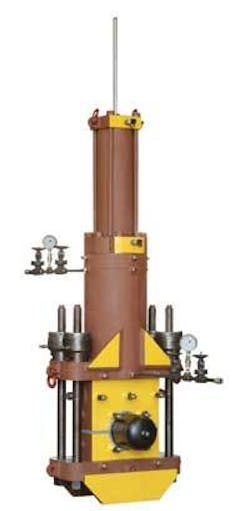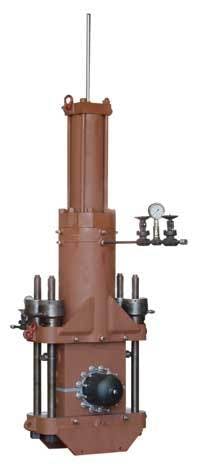Shear Plug Helps Save Money in Boiler Feedwater Loop By Kerrigan Mendicino
Plant shutdowns can be time consuming, which means running the risk of high costs. This is what an international petroleum and petrochemical company sought to avoid in July 2004.
For about two years, the plant had a problem with excessive boiler feedwater (BFW) that was leaking through two steam letdown station temperature control loops. Plant management assessed the situation and contemplated methods that could stop the leak. The only viable solution, though, was to use a shear plug that didn’t have adverse effects, such as adding metal chips in the line - but also would provide a positive metal-to-metal seal and could be safely used for an extended period of time. The petroleum and petrochemical company contacted The Pipe Line Development Co. (PLIDCO), Cleveland, OH.
The company designs and manufactures pipeline repair and maintenance fittings for applications, both onshore and offshore, for oil, gas, water, chemical, steam, slurry and other piping systems. Its products have enabled customers to make fast, safe repairs, thus avoiding or minimizing costly shutdowns. One of them seemed to fit the bill in solving this leakage problem.
The Situation
A plant will generate steam to support a process. The steam is either used for heating chemicals in the process or to drive rotating equipment. The petroleum and petrochemical company’s plant uses steam to drive a steam turbine which drives a pump.
“When we generate steam, we heat it up to very high temperatures so there’s no chance for the steam to condense back into water,” said the plant’s maintenance manager.
In letdown stations, BFW is injected into hot steam to lower and control the steam temperature. The injection takes place in an area where metal chips or sealant could not be tolerated.
In this plant’s case, excess BFW leakage was causing the steam systems to operate near saturation and allow high levels of condensate to exist in the steam. The BFW wasn’t atomizing as it should. When BFW isn’t atomized, the condensate leads to water erosion in steam system piping and causes erosion in rotating equipment. To compensate for excess water in the steam, additional steam is let down to consume the water. This maintains above saturation temperatures in the steam system.
“We make only the steam we need. By letting down additional steam, we’re actually generating more steam than we need,” said the plant’s maintenance manager. “The only thing we can do with that steam is vent it into the atmosphere.”
Losses for the company, caused by venting steam and leaking BFW, totaled several hundred thousand dollars a year when operating at maximum production rates. Equipment damage and maintenance costs also were in the hundred-thousand-dollar range per year.
Strategy
Initially, the petroleum and petrochemical company planned to repair the letdown station for a 2006 turnaround, which meant running another two years with the leakage. The leakage path for the BFW on both letdown stations was found through the temperature control valve loop bypass valves. Once the leakage path was located, it was determined repairs could be made while the system was online, but the team couldn’t isolate one of the leaks to allow this.
When considering repair options, it was determined traditional hot tap and stopple wasn’t feasible. The service was too severe for a single stopple, and a dual stopple arrangement wouldn’t work due to the piping configuration. There also were safety concerns of how much time the letdown stations needed to be plugged. And shavings from the drilling operation could potentially plug the BFW injection quill system.
The petroleum and petrochemical company considered crimping the piping. The metal-to-metal crease, however, wouldn’t provide positive leak shutoff. To achieve a positive shutoff, maintenance workers would have had to pump the crimp with leak sealant. The sealant, though, could flow into the injection system causing them to plug again.
A freeze plug was considered to stop the flow in order to replace a piping valve. But, due to the extreme hot temperatures of the BFW, the water would be unable to freeze.
The Solution
The company had weighed all its options. One of the plant’s engineers had heard that another of the company’s plants was considering using PLIDCO® Shear + Plug and that the plant should consider it as well. The plug was the best practical solution because:
• No drilling is required, so there are no shavings that could plug the BFW injection system.
• There’s a consistent metal-to-metal seal providing a positive shutoff.
• All components were rated for the service.
• The unit has a consistent service and safety record for pipe sizes 8" and below.
• There were no concerns for the seal to last two years until the 2006 turn around, and whether the plug and hydraulic ram could stay in place until then.
The plant’s site maintenance personnel and PLIDCO representatives met to develop a joint safety plan, work scope and a detailed step-by-step plan including both the maintenance activities and necessary steam system monitoring.
The proper guidelines developed, the plan was presented to the site’s safe operating committee - a cross-functional team of experienced maintenance, operations and technical employees - to review the plan. During the presentation, a DVD was played demonstrating a shearing set up on the same size equipment as the oil refinery’s plant, in PLIDCO’s research and development facility.
With committee approval, the plant began the process of setting up the new shear plug in its facility. Rigging was designed and put into place to support the weight of the equipment. Then, the split fitting was welded onto the piping, just as a split tee would be for a hot tap. A hydraulic ram was installed on the fitting using the installed rigging.
“The shear plug sliced through piping and began to shut off BFW flow. While steam system temperatures had to be monitored, potential steam flow had to be reduced as steam system temperatures rose with the decreasing BFW injection,” said the maintenance manager.
With all the preparation in place, technicians were able to install the shear plug in one shift. As the plug blocked off the flow, the process engineers observed the BFW injection rate decrease, and the steam letdown station began to control the steam system temperature. The operation was successfully completed in September 2004, eliminating 25 gpm of water leakage into the steam systems.
The second leak elimination had the proper isolations allowing conventional repair methods to replace the bypass valve.
Conclusion
Today, the plant is in full running order without any leakage. Both steam letdown stations are in control and are maintaining proper steam system temperatures at the desired letdown rates. The petroleum and petrochemical company and PLIDCO’s efforts eliminated significant imbalance in the site’s steam system, which greatly reduced the need for excessive venting. In the first month alone, since the Shear + Plug was installed, the plant reported saving $200,000 in energy expenses.
Additional outcomes included increased horsepower availability on two major compressor trains and elimination of excess condensate allowing more equipment reliability.
In 2006, the system continues to provide leak shutoff. The petroleum and petrochemical company has no doubt its 2006 turnaround won’t be hindered by BFW leakage and it will have full control of its steam systems.
As the maintenance manager says, “Over the next two years, until the turnaround, I’m not going to waste steam.”
About the Author: Kerrigan Mendicino is manager of the Shear Plug product line for PLIDCO. The ISO 900- registered, Cleveland-based Pipe Line Development Co. designs and manufactures pipeline repair and maintenance fittings and has sold hundreds of thousands worldwide in thousands of applications, both onshore and offshore. Applications include oil, gas, water, chemical, steam, slurry and other piping systems. Contact: 216-771-8200, [email protected] or www.plidco.com.
Microgy builds waste-to-energy plant
Environmental Power Corp.’s subsidiary, Microgy Inc. will build a biogas production facility at a Grand Island, NE, beef processing plant that will use its anaerobic digestion technology to extract methane-rich biogas from animal wastes, meat processing wastes and certain wastewater plant residual streams that would otherwise be landfilled or land applied. The deal with Swift & Co., the world’s second-largest processor of fresh beef and pork products, leaves the possibility open for similar efforts at up to seven other Swift facilities throughout North America.


